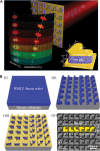Hybrid bilayer plasmonic metasurface efficiently manipulates visible light
- PMID: 26767195
- PMCID: PMC4705036
- DOI: 10.1126/sciadv.1501168
Hybrid bilayer plasmonic metasurface efficiently manipulates visible light
Abstract
Metasurfaces operating in the cross-polarization scheme have shown an interesting degree of control over the wavefront of transmitted light. Nevertheless, their inherently low efficiency in visible light raises certain concerns for practical applications. Without sacrificing the ultrathin flat design, we propose a bilayer plasmonic metasurface operating at visible frequencies, obtained by coupling a nanoantenna-based metasurface with its complementary Babinet-inverted copy. By breaking the radiation symmetry because of the finite, yet small, thickness of the proposed structure and benefitting from properly tailored intra- and interlayer couplings, such coupled bilayer metasurface experimentally yields a conversion efficiency of 17%, significantly larger than that of earlier single-layer designs, as well as an extinction ratio larger than 0 dB, meaning that anomalous refraction dominates the transmission response. Our finding shows that metallic metasurface can counterintuitively manipulate the visible light as efficiently as dielectric metasurface (~20% in conversion efficiency in Lin et al.'s study), although the metal's ohmic loss is much higher than dielectrics. Our hybrid bilayer design, still being ultrathin (~λ/6), is found to obey generalized Snell's law even in the presence of strong couplings. It is capable of efficiently manipulating visible light over a broad bandwidth and can be realized with a facile one-step nanofabrication process.
Keywords: Metasurface; high efficiency; plasmonics; visible light, coupling.
Figures





References
-
- Fang N., Lee H., Sun C., Zhang X., Sub–diffraction-limited optical imaging with a silver superlens. Science 308, 534–537 (2005). - PubMed
-
- Valentine J., Zhang S., Zentgraf T., Ulin-Avila E., Genov D. A., Bartal G., Zhang X., Three-dimensional optical metamaterial with a negative refractive index. Nature 455, 376–379 (2008). - PubMed
-
- Cai W., Chettiar U. K., Kildishev A. V., Shalaev V. M., Optical cloaking with metamaterials. Nat. Photonics 1, 224–227 (2007).
-
- Yu N., Genevet P., Kats M. A., Aieta F., Tetienne J.-P., Capasso F., Gaburro Z., Light propagation with phase discontinuities: Generalized laws of reflection and refraction. Science 334, 333–337 (2011). - PubMed
-
- Ni X., Ishii S., Kildishev A. V., Shalaev V. M., Ultra-thin, planar, Babinet-inverted plasmonic metalenses. Light Sci. Appl. 2, e72 (2013).
Publication types
MeSH terms
LinkOut - more resources
Full Text Sources
Other Literature Sources
Miscellaneous

